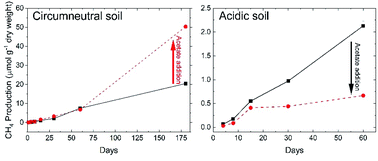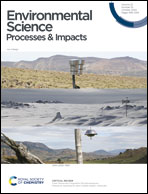Anaerobic respiration pathways and response to increased substrate availability of Arctic wetland soils†‡
Abstract
The availability of labile carbon (C) compounds in Arctic wetland soils is expected to increase due to thawing permafrost and increased fermentation as a result of decomposition of organic matter with warming. How microbial communities respond to this change will affect the balance of CO2 and CH4 emitted during anaerobic organic matter decomposition, and ultimately the net radiative forcing of greenhouse gas emissions from these soils. While soil water content limits aerobic respiration, the factors controlling methanogenesis and anaerobic respiration are poorly defined in suboxic Arctic soils. We conducted incubation experiments on two tundra soils from field sites on the Seward Peninsula, Alaska, with contrasting pH and geochemistry to determine the pathways of anaerobic microbial respiration and changes with increasing substrate availability upon warming. In incubation of soils from the circumneutral Teller site, the ratio of CO2 to CH4 dropped from 10 to <2 after 60 days, indicating rapid depletion of alternative terminal electron acceptors (TEAs). Addition of acetate stimulated production of CO2 and CH4 in a nearly 1 : 1 ratio, consistent with methanogenesis, and the composition of the microbial community shifted to favor clades capable of utilizing the added acetate such as the Fe(III)-reducing Geobacter and the methanogenic archaea Methanosarcina. In contrast, both CO2 and CH4 production declined with acetate addition during incubation of soils from the more acidic Council site, and fermentative microorganisms increased in abundance despite the high availability of fermentation products. These results demonstrate that the degree to which increasing substrate availability stimulates greenhouse gas production in tundra wetlands will vary widely depending on soil pH and geochemistry.

- This article is part of the themed collections: SDG13: Climate Action- chemistry of greenhouse gases, 2022 and Cryosphere Chemistry


 Please wait while we load your content...
Please wait while we load your content...